Qian Jiang
ManipLVM-R1: Reinforcement Learning for Reasoning in Embodied Manipulation with Large Vision-Language Models
May 22, 2025Abstract:Large Vision-Language Models (LVLMs) have recently advanced robotic manipulation by leveraging vision for scene perception and language for instruction following. However, existing methods rely heavily on costly human-annotated training datasets, which limits their generalization and causes them to struggle in out-of-domain (OOD) scenarios, reducing real-world adaptability. To address these challenges, we propose ManipLVM-R1, a novel reinforcement learning framework that replaces traditional supervision with Reinforcement Learning using Verifiable Rewards (RLVR). By directly optimizing for task-aligned outcomes, our method enhances generalization and physical reasoning while removing the dependence on costly annotations. Specifically, we design two rule-based reward functions targeting key robotic manipulation subtasks: an Affordance Perception Reward to enhance localization of interaction regions, and a Trajectory Match Reward to ensure the physical plausibility of action paths. These rewards provide immediate feedback and impose spatial-logical constraints, encouraging the model to go beyond shallow pattern matching and instead learn deeper, more systematic reasoning about physical interactions.
Audio Jailbreak: An Open Comprehensive Benchmark for Jailbreaking Large Audio-Language Models
May 21, 2025Abstract:The rise of Large Audio Language Models (LAMs) brings both potential and risks, as their audio outputs may contain harmful or unethical content. However, current research lacks a systematic, quantitative evaluation of LAM safety especially against jailbreak attacks, which are challenging due to the temporal and semantic nature of speech. To bridge this gap, we introduce AJailBench, the first benchmark specifically designed to evaluate jailbreak vulnerabilities in LAMs. We begin by constructing AJailBench-Base, a dataset of 1,495 adversarial audio prompts spanning 10 policy-violating categories, converted from textual jailbreak attacks using realistic text to speech synthesis. Using this dataset, we evaluate several state-of-the-art LAMs and reveal that none exhibit consistent robustness across attacks. To further strengthen jailbreak testing and simulate more realistic attack conditions, we propose a method to generate dynamic adversarial variants. Our Audio Perturbation Toolkit (APT) applies targeted distortions across time, frequency, and amplitude domains. To preserve the original jailbreak intent, we enforce a semantic consistency constraint and employ Bayesian optimization to efficiently search for perturbations that are both subtle and highly effective. This results in AJailBench-APT, an extended dataset of optimized adversarial audio samples. Our findings demonstrate that even small, semantically preserved perturbations can significantly reduce the safety performance of leading LAMs, underscoring the need for more robust and semantically aware defense mechanisms.
A Haptic-Based Proximity Sensing System for Buried Object in Granular Material
Nov 26, 2024



Abstract:The proximity perception of objects in granular materials is significant, especially for applications like minesweeping. However, due to particles' opacity and complex properties, existing proximity sensors suffer from high costs from sophisticated hardware and high user-cost from unintuitive results. In this paper, we propose a simple yet effective proximity sensing system for underground stuff based on the haptic feedback of the sensor-granules interaction. We study and employ the unique characteristic of particles -- failure wedge zone, and combine the machine learning method -- Gaussian process regression, to identify the force signal changes induced by the proximity of objects, so as to achieve near-field perception. Furthermore, we design a novel trajectory to control the probe searching in granules for a wide range of perception. Also, our proximity sensing system can adaptively determine optimal parameters for robustness operation in different particles. Experiments demonstrate our system can perceive underground objects over 0.5 to 7 cm in advance among various materials.
Federated Recommendation via Hybrid Retrieval Augmented Generation
Mar 07, 2024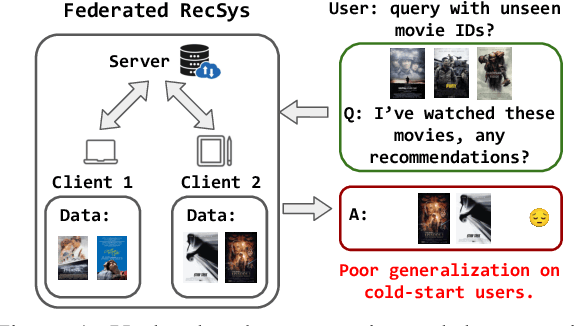
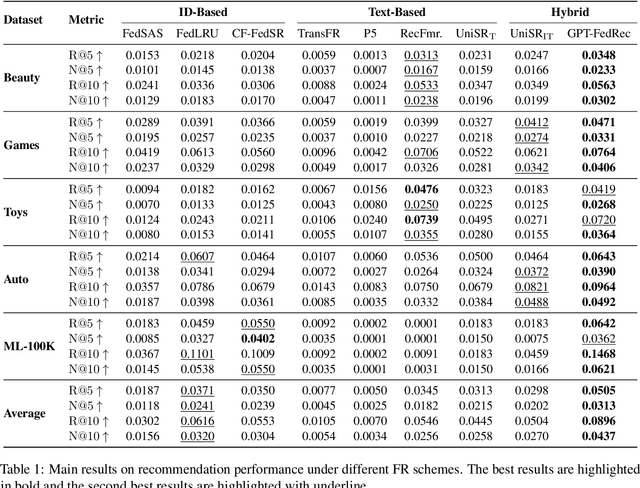

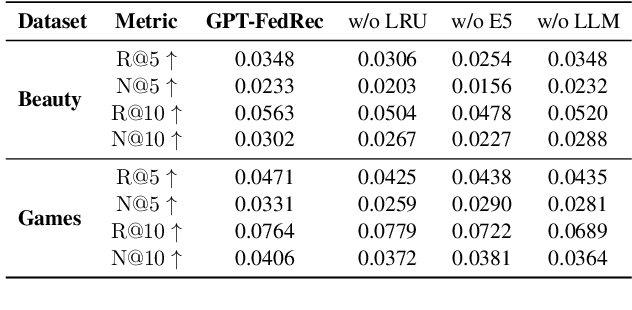
Abstract:Federated Recommendation (FR) emerges as a novel paradigm that enables privacy-preserving recommendations. However, traditional FR systems usually represent users/items with discrete identities (IDs), suffering from performance degradation due to the data sparsity and heterogeneity in FR. On the other hand, Large Language Models (LLMs) as recommenders have proven effective across various recommendation scenarios. Yet, LLM-based recommenders encounter challenges such as low inference efficiency and potential hallucination, compromising their performance in real-world scenarios. To this end, we propose GPT-FedRec, a federated recommendation framework leveraging ChatGPT and a novel hybrid Retrieval Augmented Generation (RAG) mechanism. GPT-FedRec is a two-stage solution. The first stage is a hybrid retrieval process, mining ID-based user patterns and text-based item features. Next, the retrieved results are converted into text prompts and fed into GPT for re-ranking. Our proposed hybrid retrieval mechanism and LLM-based re-rank aims to extract generalized features from data and exploit pretrained knowledge within LLM, overcoming data sparsity and heterogeneity in FR. In addition, the RAG approach also prevents LLM hallucination, improving the recommendation performance for real-world users. Experimental results on diverse benchmark datasets demonstrate the superior performance of GPT-FedRec against state-of-the-art baseline methods.
GRAINS: Proximity Sensing of Objects in Granular Materials
Jul 18, 2023Abstract:Proximity sensing detects an object's presence without contact. However, research has rarely explored proximity sensing in granular materials (GM) due to GM's lack of visual and complex properties. In this paper, we propose a granular-material-embedded autonomous proximity sensing system (GRAINS) based on three granular phenomena (fluidization, jamming, and failure wedge zone). GRAINS can automatically sense buried objects beneath GM in real-time manner (at least ~20 hertz) and perceive them 0.5 ~ 7 centimeters ahead in different granules without the use of vision or touch. We introduce a new spiral trajectory for the probe raking in GM, combining linear and circular motions, inspired by a common granular fluidization technique. Based on the observation of force-raising when granular jamming occurs in the failure wedge zone in front of the probe during its raking, we employ Gaussian process regression to constantly learn and predict the force patterns and detect the force anomaly resulting from granular jamming to identify the proximity sensing of buried objects. Finally, we apply GRAINS to a Bayesian-optimization-algorithm-guided exploration strategy to successfully localize underground objects and outline their distribution using proximity sensing without contact or digging. This work offers a simple yet reliable method with potential for safe operation in building habitation infrastructure on an alien planet without human intervention.
Understanding and Constructing Latent Modality Structures in Multi-modal Representation Learning
Mar 10, 2023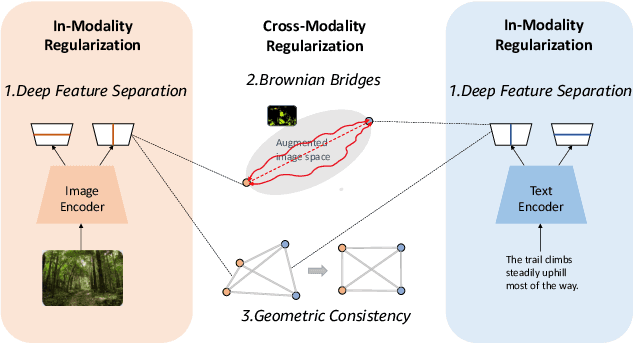
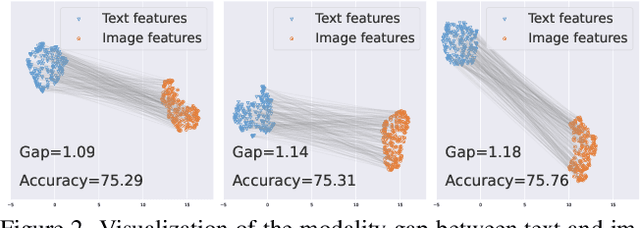
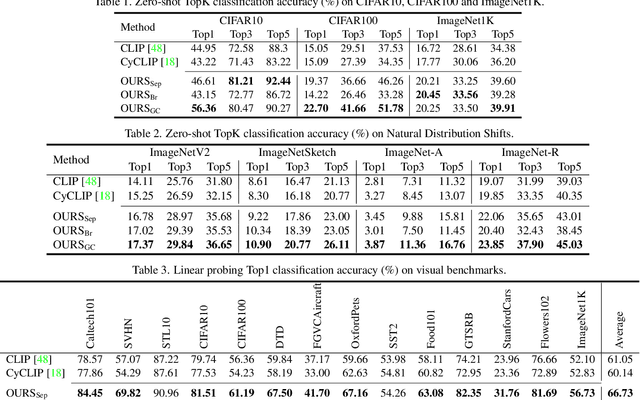

Abstract:Contrastive loss has been increasingly used in learning representations from multiple modalities. In the limit, the nature of the contrastive loss encourages modalities to exactly match each other in the latent space. Yet it remains an open question how the modality alignment affects the downstream task performance. In this paper, based on an information-theoretic argument, we first prove that exact modality alignment is sub-optimal in general for downstream prediction tasks. Hence we advocate that the key of better performance lies in meaningful latent modality structures instead of perfect modality alignment. To this end, we propose three general approaches to construct latent modality structures. Specifically, we design 1) a deep feature separation loss for intra-modality regularization; 2) a Brownian-bridge loss for inter-modality regularization; and 3) a geometric consistency loss for both intra- and inter-modality regularization. Extensive experiments are conducted on two popular multi-modal representation learning frameworks: the CLIP-based two-tower model and the ALBEF-based fusion model. We test our model on a variety of tasks including zero/few-shot image classification, image-text retrieval, visual question answering, visual reasoning, and visual entailment. Our method achieves consistent improvements over existing methods, demonstrating the effectiveness and generalizability of our proposed approach on latent modality structure regularization.
EH-DNAS: End-to-End Hardware-aware Differentiable Neural Architecture Search
Nov 24, 2021



Abstract:In hardware-aware Differentiable Neural Architecture Search (DNAS), it is challenging to compute gradients of hardware metrics to perform architecture search. Existing works rely on linear approximations with limited support to customized hardware accelerators. In this work, we propose End-to-end Hardware-aware DNAS (EH-DNAS), a seamless integration of end-to-end hardware benchmarking, and fully automated DNAS to deliver hardware-efficient deep neural networks on various platforms, including Edge GPUs, Edge TPUs, Mobile CPUs, and customized accelerators. Given a desired hardware platform, we propose to learn a differentiable model predicting the end-to-end hardware performance of neural network architectures for DNAS. We also introduce E2E-Perf, an end-to-end hardware benchmarking tool for customized accelerators. Experiments on CIFAR10 and ImageNet show that EH-DNAS improves the hardware performance by an average of $1.4\times$ on customized accelerators and $1.6\times$ on existing hardware processors while maintaining the classification accuracy.
MC-LCR: Multi-modal contrastive classification by locally correlated representations for effective face forgery detection
Oct 07, 2021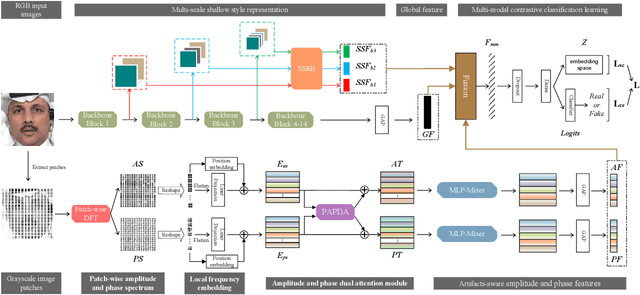

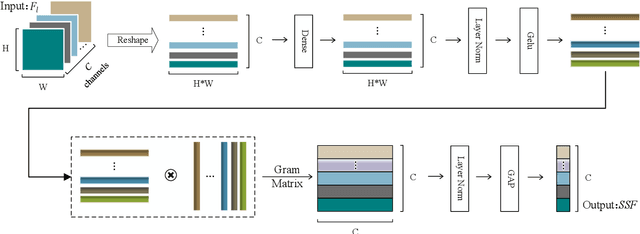

Abstract:As the remarkable development of facial manipulation technologies is accompanied by severe security concerns, face forgery detection has become a recent research hotspot. Most existing detection methods train a binary classifier under global supervision to judge real or fake. However, advanced manipulations only perform small-scale tampering, posing challenges to comprehensively capture subtle and local forgery artifacts, especially in high compression settings and cross-dataset scenarios. To address such limitations, we propose a novel framework named Multi-modal Contrastive Classification by Locally Correlated Representations(MC-LCR), for effective face forgery detection. Instead of specific appearance features, our MC-LCR aims to amplify implicit local discrepancies between authentic and forged faces from both spatial and frequency domains. Specifically, we design the shallow style representation block that measures the pairwise correlation of shallow feature maps, which encodes local style information to extract more discriminative features in the spatial domain. Moreover, we make a key observation that subtle forgery artifacts can be further exposed in the patch-wise phase and amplitude spectrum and exhibit different clues. According to the complementarity of amplitude and phase information, we develop a patch-wise amplitude and phase dual attention module to capture locally correlated inconsistencies with each other in the frequency domain. Besides the above two modules, we further introduce the collaboration of supervised contrastive loss with cross-entropy loss. It helps the network learn more discriminative and generalized representations. Through extensive experiments and comprehensive studies, we achieve state-of-the-art performance and demonstrate the robustness and generalization of our method.
FFR_FD: Effective and Fast Detection of DeepFakes Based on Feature Point Defects
Jul 05, 2021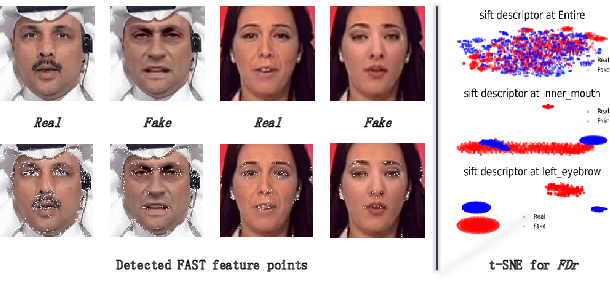
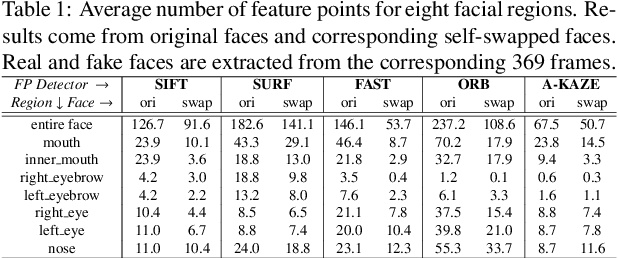
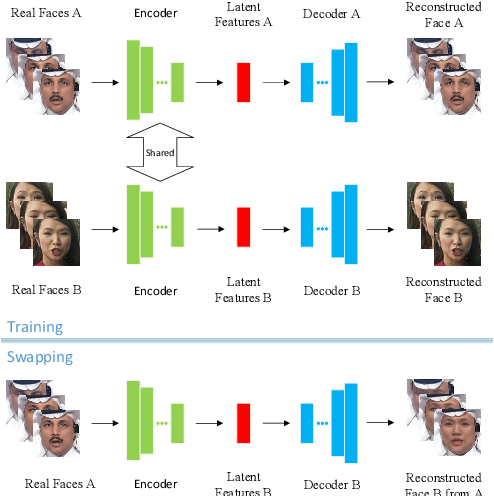

Abstract:The internet is filled with fake face images and videos synthesized by deep generative models. These realistic DeepFakes pose a challenge to determine the authenticity of multimedia content. As countermeasures, artifact-based detection methods suffer from insufficiently fine-grained features that lead to limited detection performance. DNN-based detection methods are not efficient enough, given that a DeepFake can be created easily by mobile apps and DNN-based models require high computational resources. We show that DeepFake faces have fewer feature points than real ones, especially in certain facial regions. Inspired by feature point detector-descriptors to extract discriminative features at the pixel level, we propose the Fused Facial Region_Feature Descriptor (FFR_FD) for effective and fast DeepFake detection. FFR_FD is only a vector extracted from the face, and it can be constructed from any feature point detector-descriptors. We train a random forest classifier with FFR_FD and conduct extensive experiments on six large-scale DeepFake datasets, whose results demonstrate that our method is superior to most state of the art DNN-based models.
 Add to Chrome
Add to Chrome Add to Firefox
Add to Firefox Add to Edge
Add to Edge